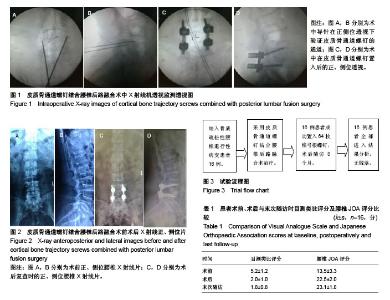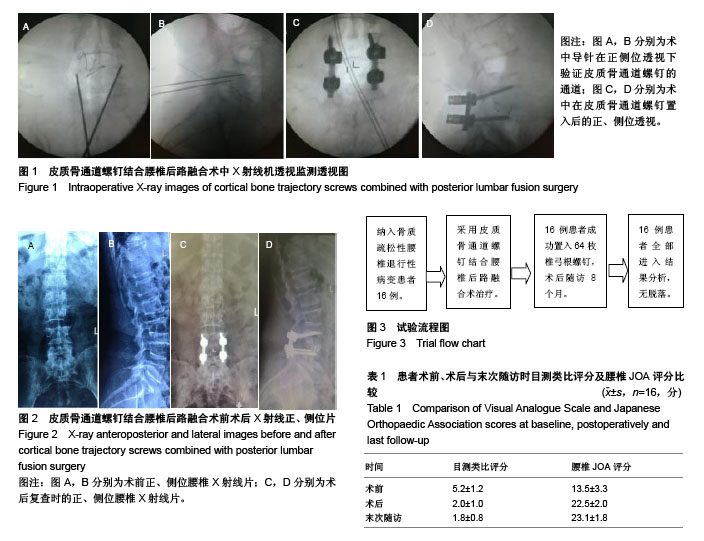Chinese Journal of Tissue Engineering Research ›› 2018, Vol. 22 ›› Issue (23): 3628-3633.doi: 10.3969/j.issn.2095-4344.0310
Previous Articles Next Articles
Application value of cortical bone trajectory screws in osteoporotic lumbar posterior fusion surgery
Hao Shen-shen, Li Chang-hong, Liu Zhi-bin, Wang Fei
- Department of Spine Surgery, Affiliated Hospital of Yan’an University, Yan’an 716000, Shaanxi Province, China
-
Online:2018-08-18Published:2018-08-18 -
Contact:Li Chang-hong, Associate chief physician, Department of Spine Surgery, Affiliated Hospital of Yan’an University, Yan’an 716000, Shaanxi Province, China -
About author:Hao Shen-shen, Master candidate, Department of Spine Surgery, Affiliated Hospital of Yan’an University, Yan’an 716000, Shaanxi Province, China -
Supported by:the Key Technologies Research & Development Program of Yan’an, No. 2017KS-06; the Social Development and Technologies Research & Development Project of Shaanxi Province, No. 2015SF115; the Science and Technology Benefiting People Program of Yan’an, No. 2016HM-10-03
CLC Number:
Cite this article
Hao Shen-shen, Li Chang-hong, Liu Zhi-bin, Wang Fei . Application value of cortical bone trajectory screws in osteoporotic lumbar posterior fusion surgery[J]. Chinese Journal of Tissue Engineering Research, 2018, 22(23): 3628-3633.
share this article

2.1 参与者数量分析 按意向性处理,纳入行CBT螺钉结合腰椎后路融合术治疗、临床资料及随访完整的患者共16例,全部进入结果分析,无脱落。试验流程图见图3。 2.2 手术安全性及可行性评估 患者手术均顺利安全完成,术中未出现神经、血管损伤等并发症及置钉相关的螺钉把持力不足或钉道破坏等导致置钉失败。术后随访过程中亦未出现螺钉松动、脱落、融合器移位等并发症。 2.3 手术相关指标评估 手术时间为(168.5±37.1) min,术中出血量为(184.2±25.9) mL。 目测类比评分方面,术后与末次随访比较,差异无显著性意义(P > 0.05),但均较术前显著改善(P < 0.05)。 腰椎JOA评分方面,术后与末次随访比较,差异无显著性意义(P > 0.05),但均较术前显著改善(P < 0.05),见表1。 末次随访时所有患者融合器均在位、均获得满意的植骨融合效果,植骨融合率达到100%。"

| [1] Mclain RF, Fry MF, Moseley TA, et al. Lumbar pedicle screw salvage: pullout testing of three different pedicle screw designs. J Spinal Disord. 1995;8(1): 62-68.[2] Chiba M, Mclain RF, Yerby SA, et al. Short-segment pedicle instrumentation. Biomechanical analysis of supplemental hook fixation. Spine (Phila Pa 1976). 1996;21(3):288-294. [3] 翁习生,邱贵兴,张嘉,等.椎弓根内固定技术的远期疗效评价[J].中华骨科杂志,2001,21(11):662-665.[4] Ponnusamy KE, Iyer S, Gupta G, et al. Instrumentation of the osteoporotic spine: biomechanical and clinical considerations. Spine J. 2011;11(1):54-63. [5] 高海,李惠民,陈银河,等.皮质骨螺钉固定与椎弓根螺钉固定在腰椎后路融合术中应用效果比较的Meta分析[J].中国脊柱脊髓杂志,2017,27(11): 977-984.[6] 邱贵兴,裴福兴,胡侦明,等.中国骨质疏松性骨折诊疗指南(全文)(骨质疏松性骨折诊断及治疗原则) [J].中华关节外科杂志(电子版),2015,9(6): 795-798.[7] Cho W, Cho SK, Wu C. The biomechanics of pedicle screw-based instrumentation. J Bone Joint Surg Br, 2010, 92(8):1061-1065. [8] Okuyama K, Sato K, Abe E, et al. Stability of transpedicle screwing for the osteoporotic spine. An in vitro study of the mechanical stability. Spine (Phila Pa 1976). 1993;18(15):2240-2245. [9] Ryan PJ, Blake GM, Herd R, et al. Distribution of bone mineral density in the lumbar spine in health and osteoporosis. Osteoporos Int. 1994; 4(2):67-71. [10] Braillon PM, Lapillonne A, Ho PS, et al. Assessment of the bone mineral density in the lumbar vertebrae of newborns by quantitative computed tomography. Skeletal Radiol. 1996;25(8):711-715. [11] Halvorson TL, Kelley LA, Thomas KA, et al. Effects of bone mineral density on pedicle screw fixation. Spine (Phila Pa 1976). 1994;19(21): 2415-2420. [12] Kumano K, Hirabayashi S, Ogawa Y, et al. Pedicle screws and bone mineral density. Spine (Phila Pa 1976). 1994;19(10):1157-1161. [13] Brantley AG, Mayfield JK, Koeneman JB, et al. The effects of pedicle screw fit. An in vitro study. Spine (Phila Pa 1976). 1994;19(15): 1752-1758. [14] Zdeblick TA, Kunz DN, Cooke ME, et al. Pedicle screw pullout strength. Correlation with insertional torque. Spine (Phila Pa 1976). 1993;18(12): 1673-1676. [15] Choma TJ, Pfeiffer FM, Swope RW, et al. Pedicle screw design and cement augmentation in osteoporotic vertebrae: effects of fenestrations and cement viscosity on fixation and extraction. Spine (Phila Pa 1976). 2012;37(26):E1628-1632. [16] Sawakami K, Yamazaki A, Ishikawa S, et al. Polymethylmethacrylate augmentation of pedicle screws increases the initial fixation in osteoporotic spine patients. J Spinal Disord Tech. 2012;25(2):E28-35. [17] Wittenberg RH, Shea M, Swartz DE, et al. Importance of bone mineral density in instrumented spine fusions. Spine (Phila Pa 1976). 1991; 16(6):647-652. [18] Santoni BG, Hynes RA, Mcgilvray KC, et al. Cortical bone trajectory for lumbar pedicle screws. Spine J. 2009;9(5):366-373. [19] Mai HT, Mitchell SM, Hashmi SZ, et al. Differences in bone mineral density of fixation points between lumbar cortical and traditional pedicle screws. Spine J. 2016;16(7):835-841. [20] Matsukawa K, Taguchi E, Yato Y, et al. Evaluation of the fixation strength of pedicle screws using cortical bone trajectory: what is the ideal trajectory for optimal fixation? Spine (Phila Pa 1976). 2015;40 (15):E873-878. [21] Matsukawa K, Yato Y, Imabayashi H, et al. Biomechanical evaluation of the fixation strength of lumbar pedicle screws using cortical bone trajectory: a finite element study. J Neurosurg Spine. 2015;23(4): 471-478. [22] Oshino H, Sakakibara T, Inaba T, et al. Erratum to: A biomechanical comparison between cortical bone trajectory fixation and pedicle screw fixation. J Orthop Surg Res. 2015;10(1):154. [23] Matsukawa K, Yato Y, Nemoto O, et al. Morphometric measurement of cortical bone trajectory for lumbar pedicle screw insertion using computed tomography. J Spinal Disord Tech. 2013;26(6):E248-253. [24] Ueno M, Sakai R, Tanaka K, et al. Should we use cortical bone screws for cortical bone trajectory? J Neurosurg Spine. 2015;22(4):416-421. [25] Tschugg A, Kavakebi P, Hartmann S, et al. Clinical and radiological effect of medialized cortical bone trajectory for lumbar pedicle screw fixation in patients with degenerative lumbar spondylolisthesis: study protocol for a randomized controlled trial (mPACT). Trials. 2018;19(1): 129. [26] Hung CW, Wu MF, Hong RT, et al. Comparison of multifidus muscle atrophy after posterior lumbar interbody fusion with conventional and cortical bone trajectory. Clin Neurol Neurosurg. 2016;145:41-45. [27] Orita S, Inage K, Kubota G, et al. One-year prospective evaluation of the technique of percutaneous cortical bone trajectory spondylodesis in comparison with percutaneous pedicle screw fixation: a preliminary report with technical note. J Neurol Surg A Cent Eur Neurosurg. 2016; 77(6):531-537. [28] Chin KR, Pencle FJR, Coombs AV, et al. Clinical outcomes with midline cortical bone trajectory pedicle screws versus traditional pedicle screws in moving lumbar fusions from hospitals to outpatient surgery centers. Clin Spine Surg. 2017;30(6):E791-E797. [29] 夏天,董双海,田纪伟,等.皮质骨轨迹螺钉在腰椎融合术中的初步应用[J].脊柱外科杂志,2017,15(6):369-373.[30] 邵明昊,吕飞舟,马晓生,等.腰椎皮质骨钉道螺钉在骨质疏松症患者中应用的三维有限元分析[J].中华老年骨科与康复电子杂志,2015,1(2):1-6.[31] Bresnahan LE, Smith JS, Ogden AT, et al. Assessment of paraspinal muscle cross-sectional area after lumbar decompression: minimally invasive versus open approaches. Clin Spine Surg. 2017;30(3): E162-E168. [32] Keorochana G, Pairuchvej S, Trathitephun W, et al. Comparative outcomes of cortical screw trajectory fixation and pedicle screw fixation in lumbar spinal fusion: systematic review and meta-analysis. World Neurosurg. 2017;102:340-349. [33] 彭俊,詹玉林,刘英杰,等.皮质骨通道螺钉与椎弓根螺钉行腰椎后路椎间融合的疗效比较[J].中国修复重建外科杂志,2017,31(11):1341-1345.[34] Lee GW, Son JH, Ahn MW, et al. The comparison of pedicle screw and cortical screw in posterior lumbar interbody fusion: a prospective randomized noninferiority trial. Spine J. 2015;15(7):1519-1526. [35] Kim KT, Lee SH, Suk KS, et al. The quantitative analysis of tissue injury markers after mini-open lumbar fusion. Spine (Phila Pa 1976). 2006;31(6):712-716. [36] 王洋,席焱海,吴学铭,等.应用皮质骨轨迹螺钉内固定治疗骨质疏松腰椎退变性疾病的临床疗效 [J].中国矫形外科杂志,2016,24(21):1938-1942.[37] 宣俊,徐道亮,王向阳.皮质骨通道置椎弓根螺钉技术的研究进展 [J].中华骨科杂志,2016,36(1):51-57.[38] Ashayeri K, Nasser R, Nakhla J, et al. The use of a pedicle screw-cortical screw hybrid system for the surgical treatment of a patient with congenital multilevel spinal non-segmentation defect and spinal column deformity: a technical note. Eur Spine J. 2016;25(11): 3760-3764. [39] Matsukawa K, Yato Y, Imabayashi H, et al. Biomechanical evaluation of cross trajectory technique for pedicle screw Insertion: combined use of traditional trajectory and cortical bone trajectory. Orthop Surg. 2015; 7(4):317-323. [40] Kaye ID, Prasad SK, Vaccaro AR, et al. The cortical bone trajectory for pedicle screw insertion. JBJS Rev. 2017;5(8):e13. [41] Mitchell SM, Hk W. Lumbar pedicle cortical bone trajectory screw: indications and surgical technique. Cont Spine Surg. 2016;17(1):6. [42] Polly DW Jr, Orchowski JR, Ellenbogen RG. Revision pedicle screws. Bigger, longer shims--what is best? Spine (Phila Pa 1976). 1998; 23(12):1374-1379. [43] 姚羽,薛华伟,赵剑,等.腰椎皮质骨通道螺钉固定系统的生物力学实验[J].中国组织工程研究,2017,21(3):362-366.[44] 王燕燕,张建锋,范顺武,等.皮质骨轨迹螺钉固定技术在腰椎翻修中的应用[J].中华骨科杂志,2017,37(18):1143-1149.[45] Phan K, Hogan J, Maharaj M, et al. Cortical bone trajectory for lumbar pedicle screw placement: a review of published reports. Orthop Surg. 2015;7(3):213-221. [46] Iwatsuki K, Yoshimine T, Ohnishi Y, et al. Isthmus-guided cortical bone trajectory for pedicle screw insertion. Orthop Surg. 2014;6(3):244-248. [47] Snyder LA, Martinez-Del-Campo E, Neal MT, et al. Lumbar spinal fixation with cortical bone trajectory pedicle screws in 79 patients with degenerative disease: perioperative outcomes and complications. World Neurosurg. 2016;88:205-213. [48] Patel SS, Cheng WK, Danisa OA. Early complications after instrumentation of the lumbar spine using cortical bone trajectory technique. J Clin Neurosci. 2016;24:63-67. [49] Cheng WK, Akpolat YT, Inceoglu S, et al. Pars and pedicle fracture and screw loosening associated with cortical bone trajectory: a case series and proposed mechanism through a cadaveric study. Spine J. 2016;16(2):e59-65. [50] 李智多,袁峰,盛晓磊,等.3D打印导板辅助腰椎皮质骨螺钉置入的可行性[J].中国组织工程研究,2016,20(48):7232-7238. |
| [1] | Zhang Tongtong, Wang Zhonghua, Wen Jie, Song Yuxin, Liu Lin. Application of three-dimensional printing model in surgical resection and reconstruction of cervical tumor [J]. Chinese Journal of Tissue Engineering Research, 2021, 25(9): 1335-1339. |
| [2] | Tang Hui, Yao Zhihao, Luo Daowen, Peng Shuanglin, Yang Shuanglin, Wang Lang, Xiao Jingang. High fat and high sugar diet combined with streptozotocin to establish a rat model of type 2 diabetic osteoporosis [J]. Chinese Journal of Tissue Engineering Research, 2021, 25(8): 1207-1211. |
| [3] | Li Zhongfeng, Chen Minghai, Fan Yinuo, Wei Qiushi, He Wei, Chen Zhenqiu. Mechanism of Yougui Yin for steroid-induced femoral head necrosis based on network pharmacology [J]. Chinese Journal of Tissue Engineering Research, 2021, 25(8): 1256-1263. |
| [4] | Zeng Yanhua, Hao Yanlei. In vitro culture and purification of Schwann cells: a systematic review [J]. Chinese Journal of Tissue Engineering Research, 2021, 25(7): 1135-1141. |
| [5] | Hou Guangyuan, Zhang Jixue, Zhang Zhijun, Meng Xianghui, Duan Wen, Gao Weilu. Bone cement pedicle screw fixation and fusion in the treatment of degenerative spinal disease with osteoporosis: one-year follow-up [J]. Chinese Journal of Tissue Engineering Research, 2021, 25(6): 878-883. |
| [6] | Song Chengjie, Chang Hengrui, Shi Mingxin, Meng Xianzhong. Research progress in biomechanical stability of lateral lumbar interbody fusion [J]. Chinese Journal of Tissue Engineering Research, 2021, 25(6): 923-928. |
| [7] | Li Shibin, Lai Yu, Zhou Yi, Liao Jianzhao, Zhang Xiaoyun, Zhang Xuan. Pathogenesis of hormonal osteonecrosis of the femoral head and the target effect of related signaling pathways [J]. Chinese Journal of Tissue Engineering Research, 2021, 25(6): 935-941. |
| [8] | Xiao Fangjun, Chen Shudong, Luan Jiyao, Hou Yu, He Kun, Lin Dingkun. An insight into the mechanism of Salvia miltiorrhiza intervention on osteoporosis based on network pharmacology [J]. Chinese Journal of Tissue Engineering Research, 2021, 25(5): 772-778. |
| [9] | Liu Bo, Chen Xianghe, Yang Kang, Yu Huilin, Lu Pengcheng. Mechanism of DNA methylation in exercise intervention for osteoporosis [J]. Chinese Journal of Tissue Engineering Research, 2021, 25(5): 791-797. |
| [10] | Xu Dongzi, Zhang Ting, Ouyang Zhaolian. The global competitive situation of cardiac tissue engineering based on patent analysis [J]. Chinese Journal of Tissue Engineering Research, 2021, 25(5): 807-812. |
| [11] | Wu Zijian, Hu Zhaoduan, Xie Youqiong, Wang Feng, Li Jia, Li Bocun, Cai Guowei, Peng Rui. Three-dimensional printing technology and bone tissue engineering research: literature metrology and visual analysis of research hotspots [J]. Chinese Journal of Tissue Engineering Research, 2021, 25(4): 564-569. |
| [12] | Chang Wenliao, Zhao Jie, Sun Xiaoliang, Wang Kun, Wu Guofeng, Zhou Jian, Li Shuxiang, Sun Han. Material selection, theoretical design and biomimetic function of artificial periosteum [J]. Chinese Journal of Tissue Engineering Research, 2021, 25(4): 600-606. |
| [13] | Liu Fei, Cui Yutao, Liu He. Advantages and problems of local antibiotic delivery system in the treatment of osteomyelitis [J]. Chinese Journal of Tissue Engineering Research, 2021, 25(4): 614-620. |
| [14] | Li Xiaozhuang, Duan Hao, Wang Weizhou, Tang Zhihong, Wang Yanghao, He Fei. Application of bone tissue engineering materials in the treatment of bone defect diseases in vivo [J]. Chinese Journal of Tissue Engineering Research, 2021, 25(4): 626-631. |
| [15] | Zhang Zhenkun, Li Zhe, Li Ya, Wang Yingying, Wang Yaping, Zhou Xinkui, Ma Shanshan, Guan Fangxia. Application of alginate based hydrogels/dressings in wound healing: sustained, dynamic and sequential release [J]. Chinese Journal of Tissue Engineering Research, 2021, 25(4): 638-643. |
| Viewed | ||||||
|
Full text |
|
|||||
|
Abstract |
|
|||||